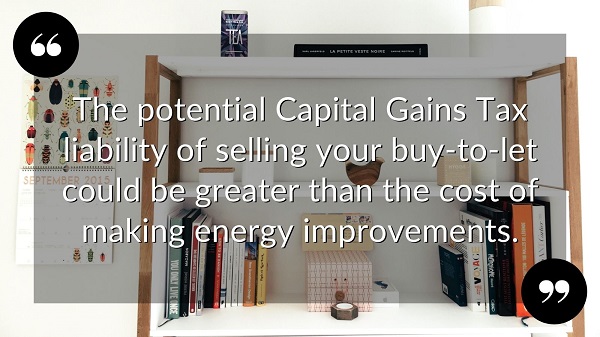What a time to be a landlord! No sooner are we past the phasing out of mortgage interest relief than the Government announces new areas of expense.

The Levelling Up white paper released on February 4th aims to make the Private Rental Sector in England and Wales more eco-friendly. It’s all part of a drive to reduce carbon emissions as part of the UK’s target to be net-zero by 2050.
While everybody agrees that energy-efficient homes are a good thing, the white paper has left landlords in the local Salisbury area and around the country with more questions than answers.
- How much will it cost to upgrade your rental property?
- Will you get that money back through higher rent?
- Is funding going to be available?
- Are you better off selling up and buying a more energy-efficient property?
- Should you stop being a landlord altogether?
There’s plenty to unpack in there, and our blog this week does just that, so you can make a plan that’s best for you.
EVALUATE YOUR EPC
Every property that is rented out needs to have a valid EPC (Energy Performance Certificate).

Here’s a quick refresher of EPC facts:
- EPCs are valid for 10 years
- Since 2018, all rented properties must have a minimum EPC rating of E
- From 1 April 2025 all new tenancies must meet band C
- By 1 April 2028 all existing tenancies must meet band C
- The current penalty for not having a valid EPC is £5,000
- From 2025, the penalty rises to £30,000
Before you make any decisions about selling or upgrading your rental property, check your EPC for its current rating and expiry date. If the rating is already C or higher, you can relax. If the EPC rating is D or E, there’s work to be done, and a good place to start is by looking at the suggestions on your certificate for improving the energy performance of your property.
HOW MUCH WILL IT COST?
If your rental property already has an EPC rating of D, the work required to reach C might be less than you think. A few relatively simple upgrades could tip you into the higher rating without major disruption or expense.

However, let’s look at how the numbers might work for a typical rental home. The Government recommends a fabric-first approach, which means insulation to roofs, walls and floors. The Impact Assessment estimates the average cost of reaching an EPC rating of C to be around £4,700.
According to the Homelet Rental Index, the average monthly rent in the UK for a new tenancy is £1,064.
If we spread the estimated cost of improvements over the 34 months between now and the end of 2024, the monthly cost comes to £138, about 13% of the rental income.
For existing tenancies where the deadline could be another three years away, that monthly cost reduces to £67, or roughly 6.3% of the rental income.
Yes, we’re talking averages, but given that it’s good practice to keep 10% of the monthly rent aside for maintenance and repairs, those figures really aren’t so tragic.
COMPARE THE COST OF LEVELLING UP VS SELLING

The big question on the lips of every landlord is whether to:
- sell it and reinvest in a more energy-efficient property
- keep and upgrade an existing buy-to-let
- walk away from lettings altogether
Some of the answers will come from the physical age of a rental property, and whether it’s owned by an individual or through a limited company. If you’re a landlord with a well-insulated and modern buy-to-let, the likelihood of major works is probably quite small. But if you own a less energy-efficient older property, you might be tempted to sell up.
So let’s look at three factors that may affect your decision:
1. Energy prices are a real hot potato right now, not least among homebuyers. Although there are no regulations around the EPC ratings of owner-occupied properties, the market for inefficient homes will be affected. This could mean less interest from buyers, or lower prices to cover the cost of upgrades.
2. Selling investment property attracts Capital Gains Tax (for individuals) or Corporation Tax (for limited companies). You’ll also need to add in legal fees and estate agents commission.
3. As well as regular Stamp Duty, buying investment property attracts a minimum of an additional 3% in the form of the Second Homes Supplement.
If you own multiple buy-to-lets through a limited company, you might choose to sell one of them to fund the renovation of others. Any profits kept in the company will escape corporation tax, and you can claim back the cost of any improvements as a legitimate business expense.
For individuals, it’s a different story. All your profits will be taxed, regardless of whether you intend to reinvest in another property. So it may turn out that keeping and upgrading your rental property is the more profitable option.
WILL THERE BE GOVERNMENT FUNDING?
Within the Government’s white paper, the phrase “where practical, cost-effective and affordable” appears. Exactly what that final caveat means we don’t yet know, but it suggests that some rental homes may be given a bit of leeway.

However, the official line right now is that most of the costs are expected to be borne by landlords, and the Government is citing improved property values as one of the benefits.
Whether landlords will have to foot the entire bill on every buy-to-let remains to be seen, and plenty of lobbying lies ahead to push the Government into backing its commitment with some kind of funding. Perhaps the 2024 General Election will provide the impetus for landlord-friendly manifesto pledges.
So, if your property is performing well, it may be worth sitting tight for now. Grants may become available, and the current pressures on energy prices may relax to make them less of a talking point for buyers and tenants.
PHASE YOUR LEVELLING UP IMPROVEMENTS
If you decide that upgrading the property is the best option, having a planned programme of works will make the cost of improvements more manageable.

By getting ahead of the deadline and setting aside some of the rental income each month, you can avoid the following hiccups and hassles:
- the financial impact of paying for everything at the same time
- a last-minute crunch of landlords trying to beat the deadline at the end of 2024
- potential increases in labour costs when demand reaches such a peak
- the stress of trying to find available contractors at a time when so many other landlords are looking
- having a property standing empty because it doesn’t meet the new legislation
Minor works can be done while your tenants are present or out at work. For major projects like replacing windows or insulating walls and floors, you could time them around your tenant’s holidays to minimise disruption.
What’s next for you?
Do you have more clarity over the best course of action for you? If you’ve still got some questions, give us a call on 01722 580059 or drop us a line at info@piccoloproperty.co.uk.
To ensure our landlord clients meet the deadline, we’ll be managing energy improvements to their buy-to-lets with our trusted and expert local contractors. So let’s get talking, and perhaps we can do the same for you.






Share this with
Email
Facebook
Messenger
Twitter
Pinterest
LinkedIn
Copy this link